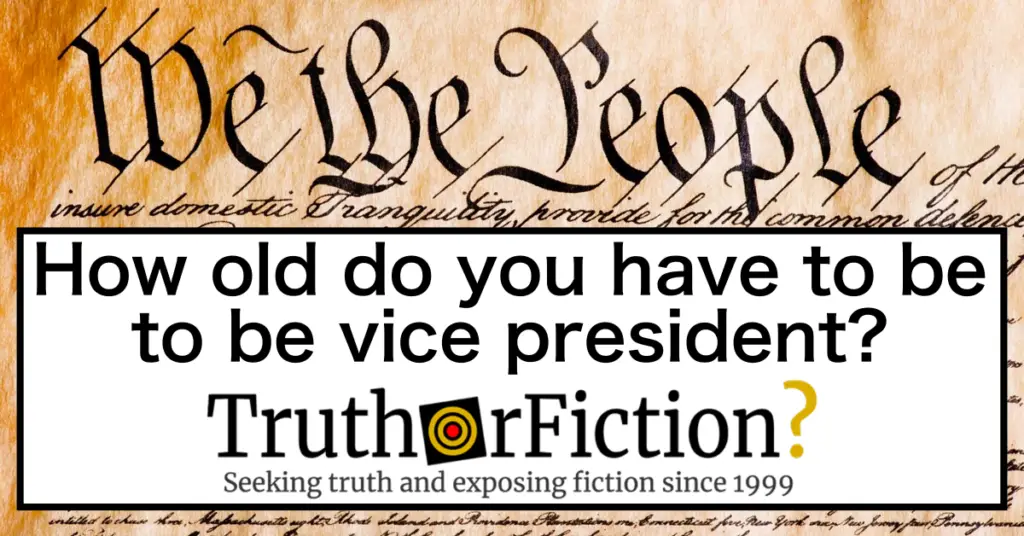A prominent element of the 2020 United States presidential race involved prominent surrogates for candidates, whose presence on campaign trails prompted questions about the minimum age requirement for an individual to become a candidate’s running mate and ultimately serve as Vice President (and President of the Senate) in their administration.
As social media and livestreaming became a larger part of campaigning, so too did the presence of political or campaign surrogates. In this sense, surrogates are notable individuals acting in the capacity of the candidate’s campaign, making speeches and trail appearances and promoting the candidate’s platform to voters across the country. One well-known surrogate for a candidate was Rep. Alexandria Ocasio-Cortez, who turned 30 in October 2019.
In order to serve as President, one of a few prerequisites involved a minimum age of 35. According to the Library of Congress, a minimum age is one of three firm requirements for presidential candidates:
Legal requirements for presidential candidates have remained the same since the year Washington accepted the presidency. As directed by the Constitution, a presidential candidate must be a natural born citizen of the United States, a resident for 14 years, and 35 years of age or older.
As noted, that requirement appears in the Constitution, in Article II, Section I:
No Person except a natural born Citizen, or a Citizen of the United States, at the time of the Adoption of this Constitution, shall be eligible to the Office of President; neither shall any Person be eligible to that Office who shall not have attained to the Age of thirty five Years, and been fourteen Years a Resident within the United States.
Whether “35 in 1789” was the same as “35 in 2020” has been the subject of some debate, although many of the United States’ Founding Fathers lived to a comfortably old age:
Some note that 35 was “older” when the Constitution was written because average life expectancy in the 1700s was much lower than it is today — about 40 years, though that’s a misleading average that counts the many who died at birth or in early childhood. Founding Father and first president George Washington lived to the age of 67. Thomas Jefferson died at 83.
A page about the age minimum from the National Constitution Center notes that upon the requirement’s adoption, it was considered in part protection against “dynastic” families in politics. That logic held that not many fathers lived to see their sons reach the age of 35:
James Monroe also wrote about the presidential age requirement making it difficult for a father and son to serve in a dynastic way. “The Constitution has provided, that no person shall be eligible to the office, who is not thirty five years old; and in the course of nature very few fathers leave a son who has arrived to that age,” he said in “A Native of Virginia, Observations upon the Proposed Plan of Federal Government.”
Turning back to the Constitution, requirements (including age) for a vice president are not necessarily explicitly spelled out. A section immediately following the portion mandating presidents be at least 35 years old reads:
In Case of the Removal of the President from Office, or of his Death, Resignation, or Inability to discharge the Powers and Duties of the said Office, the Same shall devolve on the Vice President, and the Congress may by Law provide for the Case of Removal, Death, Resignation or Inability, both of the President and Vice President, declaring what Officer shall then act as President, and such Officer shall act accordingly, until the Disability be removed, or a President shall be elected.
On a United States Senate “History” page about the Vice Presidency, it is noted that the framers’ language was “vague” in terms of presidential succession:
The [Constitution], however, was vague about the way that presidential succession would work, stating only that, in cases of presidential death or disability, the “Powers and Duties of the said Office…shall devolve on the Vice President” (Article II, section 1). What did “devolve” mean? Would the vice president become acting president until another was chosen, or would he become president in his own right? A half century would pass before the nation would have to address that murky constitutional language. Although the Constitution’s framers kept their intentions about presidential succession shrouded in ambiguity, they left no doubt about vice presidential succession. There was to be none. “[I]n the absence of the Vice President, or when he shall exercise the Office of the President of the United States” the Senate would simply choose a president pro tempore.
The Constitution was ratified on June 21 1787 after “a long and arduous process,” followed not long after by the 12th Amendment on June 15 1804. That Amendment changed the original process, wherein the runner-up served as vice president, and stipulated procedures and term-start dates. The 12th Amendment concluded:
But no person constitutionally ineligible to the office of President shall be eligible to that of Vice-President of the United States.
Although indirect, the Amendment clearly stipulated that eligibility for a vice president was predicated on eligibility to be president; no one under the age of 35 was thereby eligible to serve as vice president until such time they came of age for office. The primary stipulation appeared in the Constitution, but the secondary one was tacked on to the 12th Amendment and is not as easy to locate.
- Requirements for the President of the United States
- The Constitution of the United States: A Transcription
- Why is minimum age for president 35?
- Why does a presidential candidate need to be 35 years old anyway?
- Vice President of the United States (President of the Senate)
- 12TH AMENDMENT Election of President and Vice President

